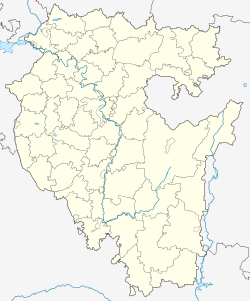메시에 62
Messier 62| 메시에 62 | |
|---|---|
 | |
| 관측 데이터(J2000 epoch) | |
| 클래스 | IV[1] |
| 별자리 | 오푸치우스 |
| 우측 상승 | 17h 01m 12.60s[2] |
| 탈위임 | –30° 06′ 44.5″[2] |
| 거리 | 22.2kly(6.8kpc)[3] |
| 겉보기 크기 (V) | +6.45[4] |
| 외관 치수(V) | 15′ |
| 물리적 특성 | |
| 절대치수 | −9.18.[5] |
| 미사 | 1.22×106[3] M☉ |
| 반지름 | 49리[6] |
| 조석 반지름 | 리로59번길[7] |
| 금속성 | / { = –1.02[8] 덱스 |
| 추정연령 | 11.78 Gyr[8] |
| 기타 지정 | C 1658-300, GCl 51, M62, NGC 6266[9] |
메시에 62 또는 M62(NGC 6266이라고도 함)는 적도의 오피우치우스 별자리의 남쪽에[a] 있는 별들의 구상 성단이다. 그것은 1771년 찰스 메시에에 의해 발견되었고,[b] 8년 후에 그의 카탈로그에 추가되었다.[10]
M62는 지구에서 약 22.2km[3], 은하 중심에서 5.5km 떨어져 있다.[2] 은하수에서 가장 거대하고 발광성이 강한 10개의 구상 성단 중 하나로, -9.18의 통합 절대 크기를 보여준다.[5] 추정 질량은 1.22×10M이고6☉[3] 질량 대 조명 비율은 코어 가시광대역인 V 대역에서 2.05±0.04이다.[11] 그것은 0.01의 예상 타원성을 가지고 있는데, 그것은 본질적으로 구면이라는 뜻이다.[12] 그것의 멤버 별들의 밀도 프로파일은 그것이 아직 핵심 붕괴를 겪지 않았음을 암시한다.[13] 코어반경은 1.3리(0.39pc), 반 질량반경은 9.6리(2.95pc), 반광반경은 6.0리(1.83pc)이다. 중심부의 항성 밀도는 입방 파섹 당 5.13 M이다☉.[14] 조석반경은 59리(18.0 pc)이다.[7]
이 성단은 별의 두 개 이상의 뚜렷한 집단을 보여주는데, 이것은 별의 형성에 관한 두 개의 별개의 에피소드를 대표할 가능성이 가장 높다. 성단의 주계열성 중 79%±1%가 1세대, 21%±1%가 2세대다. 두 번째는 첫 번째가 방출하는 물질에 의해 오염된다. 특히 헬륨, 탄소, 마그네슘, 알루미늄, 나트륨의 풍부함은 이 둘 사이에 차이가 있다.[5]
이것은 우스터호프 타입 I, 즉 "금속 부호" 시스템이라는 징후가 있다. 2010년 연구는 군집 영역에서 245개의 변수 별을 확인했는데, 그 중 209개는 RR Lyrae 변수, 4개는 타입 II 세페이드, 25개는 장기 변수, 1개는 에클립싱 이진수다. 이 성단은 RR Lyrae 변수에 있어서 은하계에서 가장 부유한 것으로 판명될 수 있다.[15] 동반자 기체에서 흘러나오는 가스로 인한 에클리핑 동작을 보이는 1개(COM6266B)를 포함해 2진수 밀리초 펄서 6개를 탑재했다.[16] 반 질량 반지름 내 50개를 포함해 여러 개의 X선원이 있다.[13] 두 별을 이항체제로 합병해 형성된 블루 스트래글러 후보 47명이 확인됐으며 이들은 핵심 지역 인근에 우선적으로 집중돼 있다.[13]
이 클러스터가 중간 질량 블랙홀(IMBH)에 호스트될 수 있다는 가정 하에, 이러한 물체를 검색하기에 적합한 것으로 간주된다. 2013년 이전에 코어의 17㎛ 이내의 항성들의 적절한 움직임에 대한 간단한 연구는 IMBH를 설명하지 않아도 되었다. 그러나, 시뮬레이션은 수천의 질량을 가진 것을 배제할 수 없다. 중심부의 아크초 내의 방사상 속도 측정에 근거하여 키슬레프 외 연구진. (2008)도 (1–9)×103 M의☉ 질량과 마찬가지로 IMBH를 주장했다.[11]
갤러리
참조 및 각주
- ^ Shapley, Harlow; Sawyer, Helen B. (August 1927), "A Classification of Globular Clusters", Harvard College Observatory Bulletin, 849 (849): 11–14, Bibcode:1927BHarO.849...11S.
- ^ a b c Di Criscienzo, M.; et al. (February 2006), "RR Lyrae-based calibration of the Globular Cluster Luminosity Function", Monthly Notices of the Royal Astronomical Society, 365 (4): 1357–1366, arXiv:astro-ph/0511128, Bibcode:2006MNRAS.365.1357D, doi:10.1111/j.1365-2966.2005.09819.x.
- ^ a b c d Boyles, J.; et al. (November 2011), "Young Radio Pulsars in Galactic Globular Clusters", The Astrophysical Journal, 742 (1): 51, arXiv:1108.4402, Bibcode:2011ApJ...742...51B, doi:10.1088/0004-637X/742/1/51.
- ^ Harris, W.E. (1996), "A Catalog of Parameters for Globular Clusters in the Milky Way", Astronomical Journal, 112: 1487, Bibcode:1996AJ....112.1487H, doi:10.1086/118116. 참고: 1997 데이터 업데이트.
- ^ a b c Milone, A. P. (January 2015), "Helium and multiple populations in the massive globular cluster NGC 6266 (M 62)", Monthly Notices of the Royal Astronomical Society, 446 (2): 1672–1684, arXiv:1409.7230, Bibcode:2015MNRAS.446.1672M, doi:10.1093/mnras/stu2198.
- ^ 거리 × sin(직경_각도 / 2 ) = 49 ly. 반경
- ^ a b Mackey, A. D.; van den Bergh, Sidney (June 2005), "The properties of Galactic globular cluster subsystems", Monthly Notices of the Royal Astronomical Society, 360 (2): 631–645, arXiv:astro-ph/0504142, Bibcode:2005MNRAS.360..631M, doi:10.1111/j.1365-2966.2005.09080.x.
- ^ a b Forbes, Duncan A.; Bridges, Terry (May 2010), "Accreted versus in situ Milky Way globular clusters", Monthly Notices of the Royal Astronomical Society, 404 (3): 1203–1214, arXiv:1001.4289, Bibcode:2010MNRAS.404.1203F, doi:10.1111/j.1365-2966.2010.16373.x.
- ^ "M 62". SIMBAD. Centre de données astronomiques de Strasbourg. Retrieved November 27, 2018.
- ^ Thompson, Robert; Thompson, Barbara (2007), Illustrated Guide to Astronomical Wonders: From Novice to Master Observer, DIY science, O'Reilly Media, Inc, p. 332, ISBN 978-0596526856.
- ^ a b McNamara, Bernard J.; et al. (February 2012), "A Search for an Intermediate-mass Black Hole in the Core of the Globular Cluster NGC 6266" (PDF), The Astrophysical Journal, 745 (2): 7, Bibcode:2012ApJ...745..175M, doi:10.1088/0004-637X/745/2/175, 175.
- ^ McNamara, Bernard J.; McKeever, Jean (November 2011), "The Dynamical Distance, RR Lyrae Absolute Magnitude, and Age of the Globular Cluster NGC 6266", The Astronomical Journal, 142 (5): 4, Bibcode:2011AJ....142..163M, doi:10.1088/0004-6256/142/5/163, 163.
- ^ a b c Beccari, G.; et al. (May 2006), "The Dynamical State and Blue Straggler Population of the Globular Cluster NGC 6266 (M62)", The Astronomical Journal, 131 (5): 2551–2560, arXiv:astro-ph/0601187, Bibcode:2006AJ....131.2551B, doi:10.1086/500643.
- ^ Baumgardt, H.; Hilker, M. (August 2018), "A catalogue of masses, structural parameters, and velocity dispersion profiles of 112 Milky Way globular clusters", Monthly Notices of the Royal Astronomical Society, 478 (2): 1520–1557, arXiv:1804.08359, Bibcode:2018MNRAS.478.1520B, doi:10.1093/mnras/sty1057.
- ^ Contreras, R.; et al. (December 2010), "Time-series Photometry of Globular Clusters: M62 (NGC 6266), the Most RR Lyrae-rich Globular Cluster in the Galaxy?", The Astronomical Journal, 140 (6): 1766–1786, arXiv:1009.4206, Bibcode:2010AJ....140.1766C, doi:10.1088/0004-6256/140/6/1766
- ^ Cocozza, G.; et al. (June 2008), "A Puzzling Millisecond Pulsar Companion in NGC 6266", The Astrophysical Journal Letters, 679 (2): L105, arXiv:0804.3574, Bibcode:2008ApJ...679L.105C, doi:10.1086/589557.
외부 링크
| 위키미디어 커먼즈에는 메시에 62와 관련된 미디어가 있다. |
- Frommert, Hartmut; Kronberg, Christine (August 30, 2007), Messier 62, Students for the Exploration and Development of Space (SEDS), retrieved 2018-11-29.
- 메시에 62, 은하계 구상 클러스터 데이터베이스 페이지
- M62는 윌릭에.그물을 치다
- 위키스키의 메시에 62: DSS2, SDSS, GALEX, IRAS, 수소 α, X선, 아스트로포토, 스카이맵, 기사 및 이미지
![{\displaystyle {\begin{smallmatrix}\left[{\ce {Fe}}/{\ce {H}}\right]\end{smallmatrix}}}](https://wikimedia.org/api/rest_v1/media/math/render/svg/4c0821bd80891e071c08e7c7ee8e022baedf522c)





